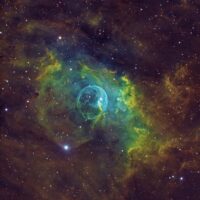Bubble Nebula in Three Palettes
Click an image for full size version
November 3, 2024
NGC 7635 lies in Cassiopeia, well placed for imaging in late summer and autumn from my locale. It’s also called the Bubble Nebula. The bubble’s glow is mainly due to excited atoms of hydrogen. This accounts for the mainly red hues of the nebula in the natural-colour RGB-only image. Oxygen and sulfur also contribute, and the other two versions are presented in tone-mapped (i.e. false) colours made using sulfur, hydrogen and oxygen filters. The Hubble palette maps these elements’ emissions to red, green and blue, respectively. This palette shows more detail than the natural-colour version, and reveals some of the chemistry of this dynamic region of space. Each hue represents a different mix of S, H, and O. The Foraxx palette uses the same narrowband data, but gives a completely different result that, in some images, reveals even more than the more traditional Hubble palette.
The Bubble Nebula is powered by the bright star inside the bubble, which is of a known as a Wolf-Rayet star. WR stars emit a lot of particles and energy, enough that they are blowing the bubble seen in this image. The central star of the bubble is between 7,000-11,000 light years away. I’ve glimpsed the brightest parts of the Bubble Nebula visually through my 20″ reflector. Photographically it’s one of my favourite objects to image.
This image has a very small field of view, but there is a lot going on around it in this very busy region in Cassiopeia. I have a wide-field shot image from 2017 here, where I provide descriptions of many of the deep-sky objects in the field.
Tekkies:
Acquisition, focusing, and control of Paramount MX mount with N.I.N.A., TheSkyX. Guiding with PHD2. Primalucelab low-profile 2″ Essato focuser, ARCO rotator and Giotto flat panel. Equipment control with PrimaLuce Labs Eagle 4 Pro computer. All pre-processing and processing in PixInsight. Acquired from my SkyShed in Guelph. Above average transparency and seeing. RGB data acquired under little moonlight, and SHO data acquired in the week around full moon, between September 13-22, 2024.
Celestron 14″ EDGE HD telescope at f/11 (3,931 mm focal length) and QHY600M-SBFL camera binned 2×2 with Optolong filters.
50x5m Red = 4hr10m
49x5m Green = 4hr05m
46x5m Blue = 3hr50m
167x5m S2 = 13hr55m
170x5m Ha = 14hr10m
167x5m O3 = 13hr55m
Total: 54hr05m
Preprocessing: The WeightedBatchPreProcessing script was used to perform calibration, cosmetic correction, weighting, registration, local normalization, integration, and auto-cropping.
Colour master: A colour master was made from the Red, Green and Blue masters using ChannelCombination in RGB mode.
Gradient Removal: DynamicBackgroundExtraction was applied to the RGB and narrowband masters.
Colour Calibration: ColorCalibration was used to calibrate the RGB master.
Deconvolution: BlurXterminator was used on the RGB and narrowband masters with Automatic psf at default settings.
Linear Noise Reduction: NoiseXterminator was applied to the RGB and narrowband masters with settings Amount=0.9 and Detail=0.35
Star Removal: StarXterminator was used to remove the stars from each of the RGB and narrowband masters, with default settings. Only the RGB stars-only image was preserved.
Hubble Palette Image Creation: The H and O masters were balanced to S using LinearFit and combined using ChannelCombination in RGB mode.
Stretching: HistogramTransformation was applied to the RGB, SHO and narrowband masters to make pleasing images. Approximate background level after the stretches was 0.10 for RGB and SHO and 0.09 for the individual narrowband masters.
Nonlinear Processing
Foraxx Palette Image Creation: The stretched S, H and O masters were combined with Paul Hancock’s Foraxx Palette Utility script.
Background Cleanup: Artifacts that were visible in the three master images were removed using the CloneStamp tool.
Nonlinear Noise Reduction: NoiseXterminator was used to reduce noise in the background areas of the RGB, Hubble and Forrax palette masters with settings Amount=0.9 and Detail=0.15
Dynamic Range Compression: The CreateHDRImage script was used to compress the core of the nebula using a mask made with the RangeSelection tool. This was applied to all three images.
Contrast Enhancement: LocalHistogramEqualization was applied twice to each image. A Contrast Limit of 1.5 and 1 iteration was used for each LHE application (scale 1150, strength 0.18; scale 50, strength 0.22).
Brightness Enhancement: Using a mask to protect the background and bright parts of the nebula, the faint parts of the nebula were brightened in each master image with ExponentialTransformation and CurvesTransformation.
Sharpening: A mask was used to select brighter regions of nebulosity in each image for sharpening with MultiscaleMedianTransform (Layers 2 – 4 with strengths of 0.07, 0.07, and 0.03, respectively).
Hubble Palette and Foraxx Colour Adjustments: CurvesTransformation was used with the Hue tool to adjust the colour tones in the two narrowband images.
Star Processing and Restoration: HistogramTransformation was used to stretch the stars-only RGB image, followed by CurvesTransformation through a star mask to boost saturation using the Saturation and CIE c* sliders. The stars were added back into the three master images using the Screen blending mode in PixelMath with the expression combine(starless, stars, op_screen()).
Final Steps: Background, nebula and star brightness, contrast and saturation were adjusted using several iterations of CurvesTransformation, with masks, as required. ICCProfileTransformation (sRGB IEC61966-2.1; Relative Colorimetric with black point compensation) was applied prior to saving as a jpg. The finder chart was made using the FindingChart process.










Leave A Comment